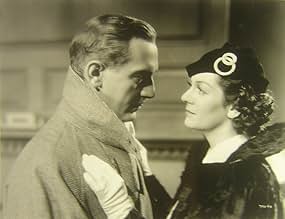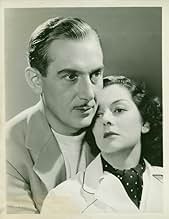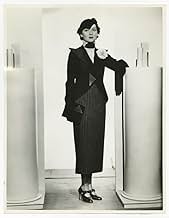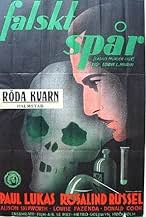PUNTUACIÓN EN IMDb
6,1/10
881
TU PUNTUACIÓN
Añade un argumento en tu idiomaAfter socialite Lynn Llewellyn receives an anonymous threat, he is poisoned at his uncle's casino, and although he recovers, his wife is murdered by the same killer.After socialite Lynn Llewellyn receives an anonymous threat, he is poisoned at his uncle's casino, and although he recovers, his wife is murdered by the same killer.After socialite Lynn Llewellyn receives an anonymous threat, he is poisoned at his uncle's casino, and although he recovers, his wife is murdered by the same killer.
- Dirección
- Guión
- Reparto principal
Purnell Pratt
- District Attorney John Markham
- (as Purnell B. Pratt)
Leo G. Carroll
- Smith
- (as Leo Carroll)
Ernie Adams
- Husband of Fat Lady at Auction
- (sin acreditar)
Brooks Benedict
- Casino Patron
- (sin acreditar)
Edna Bennett
- Nurse to Lynn
- (sin acreditar)
Sidney Bracey
- Waiter
- (sin confirmar)
- (sin acreditar)
Reseñas destacadas
This is the eighth Philo Vance mystery film, and the only one starring Paul Lukas as Vance. Under the influence of the first 'Thin Man' film, which came out the year before, the Philo Vance series here has undergone a drastic image 'makeover', to try to emulate the new William Powell series and compete with it. Suddenly everybody has a butler and there are lots of servants running around, grand surroundings, and an air of opulence previously entirely lacking from this series. The producers realized that William Powell's new series enjoyed popularity partially because of these factors, which provided audiences with an enjoyable fantasy of affluence in the wake of the horrible Great Depression. The producers obviously had not previously considered this factor, and were forced to raise their budget to accommodate better sets. This Vance film suffers from the replacement of Didier Girardot as the coroner with a truly irritating grumpy old man (Charles Sellon), so that the comic elements of the character of the coroner are entirely lost. Another ill-advised replacement was eliminating fog-horn-voiced Eugene Palette as Sergeant Heath and replacing him with an oafish actor (Ted Healy) who makes that character also lose his effectiveness by becoming completely ridiculous, and the whole thing is entirely misjudged as far as those two regular characters are concerned. Clearly, the 'freshening up' exercise and its 'new broom' were entirely destructive there. Paul Lukas is always a very congenial and watchable actor, and it is good to have a Vance film with him in it. He is very sophisticated and his slight Hungarian accent, which goes unexplained in the story of course, adds that touch of cosmopolitanism which always benefits characters such as Philo Vance. Lukas is a much warmer Vance than Powell, Rathbone, or William were, but less mischievous than Powell and less humorous than William. The plot of this film is immensely complex, with numerous red herrings. People keep getting killed, but how and why? The poison cannot be detected in the internal organs in autopsies, and yet people are being poisoned. This is eventually explained by the poison being mandragora administered in eye drops. Beat that! However one victim is not poisoned. Is it suicide or murder? The plot thickens, and thickens, and thickens, until it ends up as clotted cream. The film is very stylish and amusing, has a challenging plot, and is a successful Vance film. It is a pity that Lukas vanishes in the next one. All these Vances, who can keep up with them? This film is greatly lightened-up by the sparkling appearance of Rosalind Russell as the female lead. She always added that something extra to any film she was in. She and Lukas go for each other in a big way, and this is a conscious production decision to inject some romance into the series. Alison Skipworth swings her great bulk about with great authority as a domineering matriarch in this film, and is most amusing, though one wouldn't want to be related to her. When she turns around, it is like an ocean liner being pulled by tugboats. Leo G. Carroll appears as a rather silent and dour butler, whom one is meant to suspect as one of the many potential villains in the story. He retains an impeccable air of ambiguity to facilitate this false lead. This film perhaps marks a slight ad-Vance.
As good an actor as Paul Lukas is, his accent destroys the illusion that he's the great American detective, Philo Vance, and I was conscious of that throughout. The murder mystery gets off to a good start, but then falters when Vance speculates that perhaps it was "heavy water" that was used as the poison, since it was not known if that substance was poisonous. That idea was pulled out of thin air in an effort to explain why people drinking water would be poisoned. I disliked this development, sensing it was just a plot device to keep the movie rolling, and I was right. He mentions deuterium, Harold Urey's experiments, and the fact a quart of the substance would be worth $100,000, but I'm sure 99% of the 1935 audience didn't know what he was talking about anyway. It would have been much better if he came across Kinkaid's laboratory isolating heavy water by accident and then thought about the possibility of its use as a poison.
But I did enjoy some of the comic relief. William Demarest plays an auctioneer trying to convince people that an ugly statue of cupid was made for Louis XIV, even after his assistant announces it says "made in Japan" on the bottom. In a running gag, Louise Fazenda plays the maid who is caught a dozen times listening at a keyhole and sheepishly says "Did you call, sir," each time. And Charles Sellon is the coroner always complaining about the inconsiderate murder victims getting bumped off just when he's trying to sleep. And there's more comedy too.
But I did enjoy some of the comic relief. William Demarest plays an auctioneer trying to convince people that an ugly statue of cupid was made for Louis XIV, even after his assistant announces it says "made in Japan" on the bottom. In a running gag, Louise Fazenda plays the maid who is caught a dozen times listening at a keyhole and sheepishly says "Did you call, sir," each time. And Charles Sellon is the coroner always complaining about the inconsiderate murder victims getting bumped off just when he's trying to sleep. And there's more comedy too.
In the wake of the success of The Thin Man, the studios began to churn out scads of little mystery movies that are really more like screwball comedies than problems in deduction or thrillers. This is a pretty good sample of the type, with Rosalind Russell showing a flair for the genre that would be exploited in His Girl Friday. It even takes about 15 minutes or so before anyone gets murdered.
Paul Luckas is fine as the sleuth in the picture. Any resemblance between him and the Philo Vance depicted in the series of novels by S.S. Van Dine is a coincidence. This Philo is charming, polite, and doesn't mind when Roz complains that his mystery stories are wordy and complicated. And shouldn't come as a surprise that this Philo is more seems more interested in Roz than the mystery at hand. The actual crime is mildly intriguing, but the solution is mildly ridiculous.
Treat this as a pleasant way to spend a little more than an hour, and look at cool 30s cars, clothes and decor. Don't look for great art here.
Paul Luckas is fine as the sleuth in the picture. Any resemblance between him and the Philo Vance depicted in the series of novels by S.S. Van Dine is a coincidence. This Philo is charming, polite, and doesn't mind when Roz complains that his mystery stories are wordy and complicated. And shouldn't come as a surprise that this Philo is more seems more interested in Roz than the mystery at hand. The actual crime is mildly intriguing, but the solution is mildly ridiculous.
Treat this as a pleasant way to spend a little more than an hour, and look at cool 30s cars, clothes and decor. Don't look for great art here.
One of many films with Philo Vance as the protagonist but the only one with Paul Lukas as the famed detective. He isn't a perfect fit as Vance but does a good job nonetheless.
The real reason to catch this is to get a glimpse of Rosalind Russell early in her career. At this point she was starting to get mired in, as she referred to them, "Lady Mary" roles all dignity, stiff upper lip and little humor. This part hints at the skillful comedienne she was to become. This was only her fifth film but the first where her name appeared above the title a clear sign that the studio had bigger plans for her than to be a leading lady in B pictures.
As for the mystery it's not terribly hard to figure out but it's stylishly shot with a good supporting cast.
The real reason to catch this is to get a glimpse of Rosalind Russell early in her career. At this point she was starting to get mired in, as she referred to them, "Lady Mary" roles all dignity, stiff upper lip and little humor. This part hints at the skillful comedienne she was to become. This was only her fifth film but the first where her name appeared above the title a clear sign that the studio had bigger plans for her than to be a leading lady in B pictures.
As for the mystery it's not terribly hard to figure out but it's stylishly shot with a good supporting cast.
I enjoy the old movies, no CGI or special effects as there are today. If there are deficiencies its due to the writers. The
¿Sabías que...?
- CuriosidadesSeventh of fifteen films in the "Philo Vance" series released from 1929 to 1947 that began with ¿Quién la mató? (1929). The novels by S.S. Van Dine were extremely popular and studios bade for the film rights to each one, making the author very wealthy.
- PifiasWhen Virginia is poisoned, the doctor who examines her states that her pupils were dilated so much that he could barely see the retinas. The retina is a membrane in the back of the eye. He meant that he could barely see the iris, which is the colored part of the eye in which the pupil exists. A doctor should have known the difference.
- Citas
Philo Vance: [after smashing a garish statue of an angel] The man who destroys a monstrosity like this does more than a man who creates a masterpiece.
- ConexionesFollowed by Ojos que matan (1936)
- Banda sonoraSymphonische Dichtung 'Les Préludes'
(1848) (uncredited)
Music by Franz Liszt
Played on a car radio, but morphed into the score
Selecciones populares
Inicia sesión para calificar y añadir a tu lista para recibir recomendaciones personalizadas
- How long is The Casino Murder Case?Con tecnología de Alexa
Detalles
- Duración1 hora 22 minutos
- Color
- Relación de aspecto
- 1.37 : 1
Contribuir a esta página
Sugerir un cambio o añadir el contenido que falta

Principal laguna de datos
By what name was El crimen del casino (1935) officially released in India in English?
Responde





































